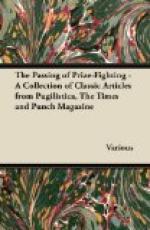“Ah!” she said at last, pointing the boy out to the porter, “there he is! At that table with all the young gentlemen. Doesn’t he look fine? And don’t they fit him beautifully? Why, no one would know the difference if he were to sit down and one of those young gentlemen were to wait on him.”
E.V.L.
* * * * *
PIGLETS.
While waiting for proof-sheets of my book on The Dynamic Force of Modern Art I thought I might get a certain amount of amusement out of a little correspondence with my neighbour, Mr. Gibbs, small farmer and dairyman, between whom and myself letters had passed a short time ago on the subject of a noisy cow, since removed from the field below the study window of the house that has been lent me by my friend Hobson. With this end in view I wrote to Mr. Gibbs as follows:—
My dear Mr. Gibbs,—The field of the uproarious cow has, I notice, suddenly become tenanted again, this time by what appears to be a school, herd or murrain of swine. Their number seems to vary. Sometimes I count ten younglings, sometimes as many as thirteen, and once I made it as much as fourteen.
Did you know they were there, or are they a crop? Or is the field suffering from swine fever, of which they are the outward manifestation? Anyhow, whether they are friends of yours or have merely just happened, as it were, they are distinctly intriguing.
My wife was remarking to me only yesterday how nice some pork would be as a change from the eternal verities, beef and mutton, and I told her that if she would look out of my window she would see the pork running about, simply asking for it. There are so many of these piglets that I don’t think the old sow would miss one. Swine can’t count, can they?
But apart from food values they interest me as subjects for the Cubist, the Vorticist and other exploiters of dynamic force in the Art of to-day (I fancy I told you in a previous letter that I am engaged upon a tome on this subject).
Figure to yourself, mon ami, what delightful rhomboidal figures Wyndham Lewis and his school would make of these budding porkers with the sleek torso and the well-poised angular snout, and, having visualised their treatment of the theme, compare it with the painted effigies of such animals by George Morland, which were merely pigs, Sir, and nothing more. No symbolism, no force. You get me—what?
But looking at these piglets from a more intimate point of view, don’t you think (if they should happen to be yours, and you have any influence with their parents) that something should be done about their faces? They have such a pushed-in appearance. Can this be normal? If so, it must seriously interfere with their truffling. But perhaps this is not good truffle-hunting country. I’m sorry if this is so, as I could do with a nice brace of truffles now and again.
Remember me kindly to our mooing friend, and believe me, dear Mr. Gibbs,




